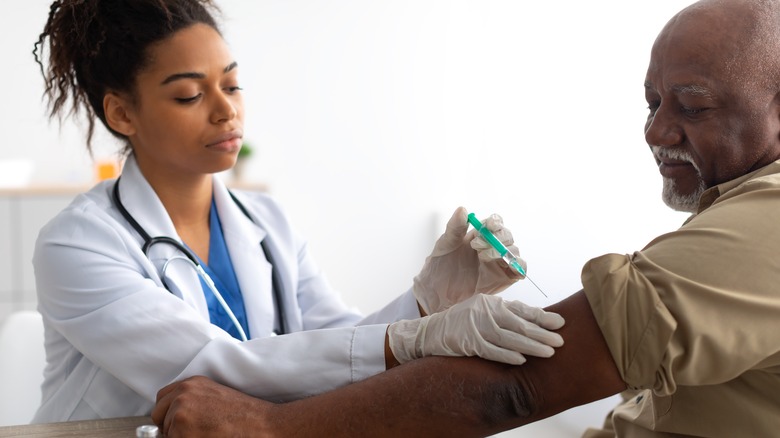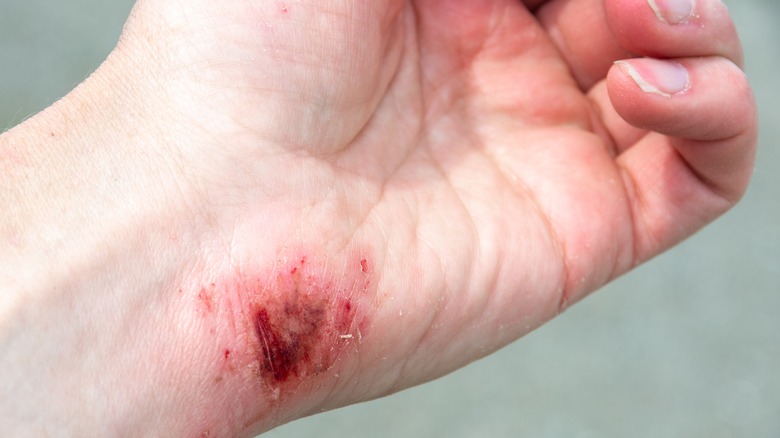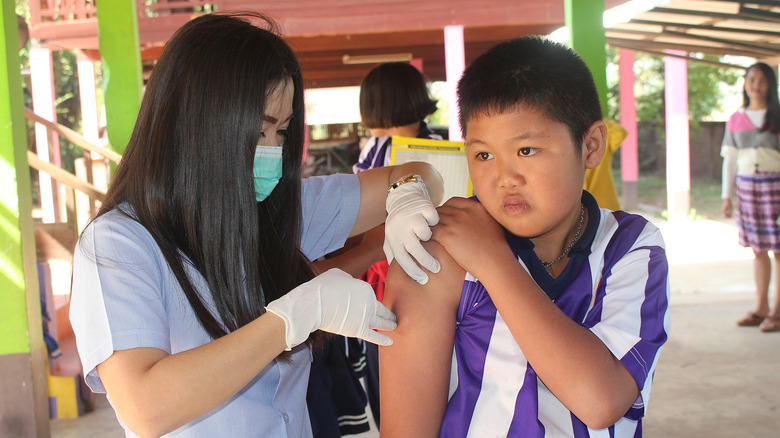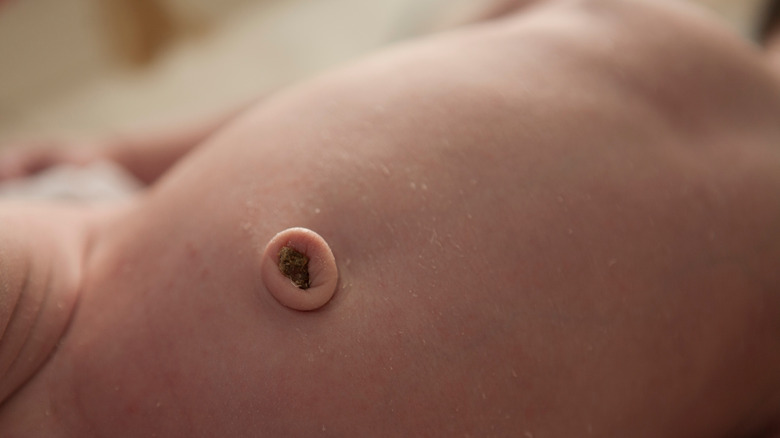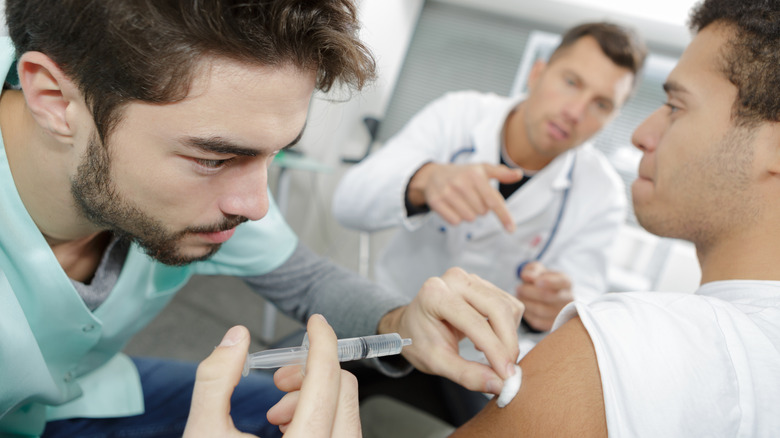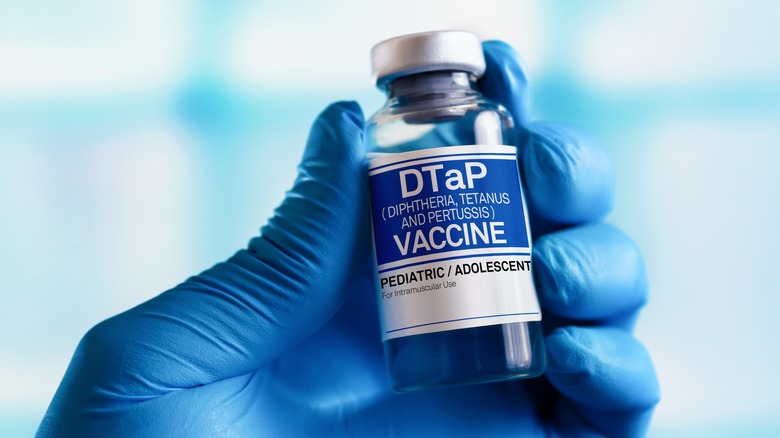Tetanus Explained: Causes, Symptoms, And Treatments
The story of a youngster (six years of age) who got a cut on his forehead while having fun on a nearby farm in Oregon — and who ended up in the intensive care unit after several days due to contracting tetanus — paints a clearer picture of how fast the tetanus condition can become life-threatening, according to the Centers for Disease Control and Prevention (CDC). And considering that a sum of a little more than $800,000 in less than 60 days is what the boy's parents paid (without factoring in transportation costs, inpatient services, and follow-up expenses) to get him out of danger, it's evidently clear that tetanus can turn almost everyone's life around pretty quick. Fortunately, the boy survived and was able to get back to his usual activities — however, this isn't always the case for everyone who gets tetanus.
Another article on the CDC points out that certain countries don't offer intensive care services for tetanus and almost all the people (there) who get the health problem end up losing their lives. And the Mayo Clinic adds that those who don't die of the condition, end up having serious health issues such as broken bones, breathing difficulties, pneumonia or lung artery blockages.
Learning about tetanus and being aware of the common causes, risk factors, and the best prevention measures for you to take can save you the financial stress, and the worry and anxiety that comes when you or your loved ones get tetanus. We aim to empower you with all the information you require about tetanus to keep yourself and your family protected.
The popular causes of tetanus
According to News Medical Life Sciences, a type of bacteria known as Clostridium tetani brings about tetanus. It gives rise to spores that help preserve the bacteria in the environment for as long as 40 years and beyond. With the spores, the bacteria is usually in a dormant state and can take shelter in the dirt, soil, and human and animal excrement. When the spores find a way to get into your body, they start functioning again. The Centers for Disease Control and Prevention (CDC) notes that the several ways the spores can penetrate your body are via injuries from needles and nails, burns you get on your body, injuries that contain dead tissue, and wounds infected by saliva, human excrement, and dirt.
However, the spores may still enter the bloodstream through other unexpected ways such as insect bites, taking drugs by injecting them into one of the veins in your body, surgery, dental health conditions, chronic illnesses and sores, compound bone fractures, and through treatment shots injected in one of the muscles in your body. Once the spores are in your body, it generally takes them a period of eight days for infection (and illness) to occur. For some, the period may be longer or shorter than that, going by the type of wound, severity of the infection, and level of contamination of the wound.
News Medical Life Sciences also explains that the spores aim for the nervous system by releasing a toxin that affects the system's regular operation — bringing about muscle contraction that eventually leads to stiff muscles and muscle spasms.
The different forms of tetanus
Tetanus exists in various forms including cephalic, generalized, and localized tetanus, explains the Centers for Disease Control and Prevention (CDC). Cephalic tetanus (also called cerebral tetanus, per the National Library of Medicine) is the most uncommon form which features face and head abrasions. It's sometimes also linked to an ear infection called otitis media — which targets the back of the eardrum. It takes about two days for this form to affect and manifest itself in the infected person. It may lead to reduced function of the cranial nerves — the nerves which are behind the brain — or an entire loss of function. Jaw muscle twitches may occur too and this form of tetanus may advance to generalized tetanus.
Generalized tetanus is a widespread form that affects about eight in every 10 people with tetanus. Its common indicators are muscle spasms around the neck and torso and tightening of the jaws. In extreme cases, convulsions and health issues that resemble seizures may occur. One subtype of generalized tetanus is neonatal tetanus — that's seen in babies who don't get covered by their mothers' antibodies. Localized tetanus, as the name hints, is a form of tetanus that's based around a particular area of the body that's often near an injury. For some people, the condition may advance to generalized tetanus (via the CDC).
Risk factors
Of all risk factors, the biggest is failing to get tetanus vaccination or not continuing with the booster shots — as required — for full protection (per the Mayo Clinic). The National Academies explains that failing to get the vaccination increases the likelihood of getting tetanus when your body comes into contact with the bacteria since your body isn't well-prepared to deal with the toxins released by the tetanus-causing bacteria. And avoiding the follow-up tetanus booster shots after a decade maximizes your odds of developing tetanus.
Another risk factor is letting any wounds or cuts remain open and then frequenting places with dung or soil — where the spores of the bacteria set camp as they wait to enter the human body. And if you also have a wound and then foreign objects from the environment like small sharp pieces of glass or wood (or even a nail) get into that wound, you're highly likely to get the condition. If you've had health issues that affect your immune system in the past or if you have diabetes and end up getting infected wounds on your skin, you also stand the risk of getting tetanus. Moreover, using other people's needles to get harmful drugs into your body also brings you closer to tetanus. And when it comes to babies, if you're a pregnant woman who hasn't received tetanus vaccination and — while you're pregnant — an umbilical cord infection occurs, your baby is more likely to have tetanus (via the Mayo Clinic).
Signs and symptoms
In many cases, lockjaw will be among the first observed signs and symptoms. The muscles in your jaw become hardened and it becomes difficult to move them as usual. Sometimes the muscles on your back, chest, abdomen, and neck may get affected too (per Penn Medicine). Breathing difficulties may also occur when the condition targets the muscles linked to breathing. When muscle spasms persist, a condition referred to as tetany (where there's an unexpected and extremely severe tightening of certain muscle groups in your body) may come about and lead to the tearing of some of the muscles as well as bone breakage. Symptoms that may also manifest when you have tetanus are having a hard time swallowing, being highly sensitive, drooling, muscles twitches in your hands and feet, and sweating profusely.
For those with the generalized form of tetanus, you may also notice smiling unwillingly due to the tightly stretched lip muscles. As time passes, you may begin having muscle contractions that are similar to seizures that persist for extended periods. Often these contractions can occur when your senses of touch, smell, and sight get aroused. In worst-case scenarios, your heart rate may get elevated and you may also get hypertension or hypotension, explains the Mayo Clinic.
Tetanus and children
When it comes to children, tetanus manifests itself pretty much in the way it does in adults. When your child gets the condition, you'll notice symptoms like muscle rigidity, fever, an unusually quick pulse, and having a difficult time swallowing. When you notice these symptoms continuing for a period, as well as new ones coming up, you should take your child for a medical check-up right away. In terms of causes, there's a slight difference between children and adults. In countries that are still on the come up, tetanus cases may be on the higher side due to infections in umbilical cord remnant on the child. Since these countries don't have adequate resources to handle the remnant well, bacteria may get into the body through the cord and cause tetanus. This explains why the recorded tetanus cases are often more in such countries than in already established countries like the United States (via the Stanford Medicine Children's Health).
Most countries ensure that babies receive tetanus shots to keep the condition at bay. A baby receives their first vaccination at two months, the second at four months, the third at six months, the fourth at around one year and three months to one year and six months, and the fifth dose at four to six years. At times, your child may receive another dose when they get around the age of 11 to 12, according to the Centers for Disease Control and Prevention (CDC).
Diagnosis
Diagnosing tetanus involves three main steps: Reviewing your medical history, analyzing your vaccination pattern through the years, and carrying out a physical examination. The doctor will also want to know more about the symptoms you're experiencing and focus more on pain, muscle stiffness, and muscle contractions. Based on the assessment, if the doctor feels that your symptoms may be for a different health issue, they may go ahead and carry out tests to confirm which condition you really have (via the Mayo Clinic).
Other than the diagnosis, another common assessment in people who are at a higher risk of getting tetanus is gauging the number of tetanus antibodies (also called antitoxins) that help deal with the toxin that cause tetanus (per the DergiPark). Several tests that help determine the levels of antitoxins in your body exist, which include the toxin neutralization test (which is slightly costly, administered by experienced specialists, and which can sense very little amounts of antitoxin), the passive hemagglutination test (which works with a more convenient layout), the radioimmunoassay test, and the ELISA test (which helps ascertain the levels of tetanus antibody through titration).
Treating tetanus
Healthline explains that the gravity of your condition will often dictate the treatment. The most common treatment methods for tetanus are muscle relaxers (for regulating muscle contractions), antibiotics (penicillin, for instance) that get rid of the bacteria that bring about tetanus, and tetanus immune globulin that minimizes the toxins released by the tetanus bacteria. When it comes to tetanus immunoglobulin, Medical News Today reports that this treatment method works best for those who have wounds that have claimed a significant amount of tissue, wounds that require surgery but there's been postponement of the surgery for more than six hours, people who have systemic sepsis who also have wounds on their bodies, injuries exposed to soil or dung, and bone issues where the bone remains unprotected and prone to illness.
Tetanus immunoglobulin is an instant temporary fix that helps to keep tetanus away — pregnant women and nursing moms can receive it (via Medical News Today). However, it shouldn't be used in place of tetanus vaccination which helps to provide extended defense. Healthline also adds that your doctor may recommend getting a tetanus vaccine together with your treatment, so don't get surprised when you see tetanus vaccination as part of your prescription. The wound that the bacteria used as an entrance to your body may also get disinfected to eliminate the bacteria from the roots. A medical expert should be the only one doing the wound disinfection on someone with tetanus (via Medical News Today).
Surgery for tetanus
Surgery becomes an option when the tetanus-infected wound is huge. In such a case, it's important for the doctor to do away with the affected muscle (whether it's infected or destroyed), and at times, the doctor may get rid of a huge chunk of the muscle if the affected area is massive. This type of surgery is known as debridement, and it's used in tetanus cases to do away with the animal dung or dirt that may be responsible for the infection. Debridement helps to discard the harmful object in your body or an infected (or dead) tissue, explains Medical News Today. And My Health Alberta reports that the importance of debridement is not only to clear the tetanus infection but to also accelerate the recovery process of a wound, to clear the dead tissue that may allow more bacteria to infect your body in the future, and that may also cause obstruction to the healthy tissue that may still be growing.
There are mainly three ways to remove dead tissue in your body: Through ointments, by carefully making incisions to the tissue, and through skin graft (where the cut tissue has affected tissues and muscles so severely that the health specialist has to remove a huge chunk of the tissue and then graft new tissue so it can replace the removed tissue). Once that's done, you'll have to allow the natural healing process for the wound to take its course. And the period it'll take for full recovery is often dependent on the severity of your specific case and other health issues you have. Proper wound care shortens the healing period.
Tetanus shots
The World Health Organization (WHO) notes that those who — after receiving treatment and fully recuperate — are not entirely safe from getting tetanus the second time. Their immunity may still not be strong enough to keep them from getting infected by the Clostridium tetani bacteria. That being the case, tetanus immunization is strongly recommended. "There are many kinds of vaccines used to protect against tetanus, all of which are combined with vaccines for other diseases" (via WHO). These vaccines include tetanus, diphtheria-tetanus, and pertussis vaccines. Although the names sound quite similar, there are fundamental differences between one vaccine and other seemingly similar ones (via the CDC).
The tetanus, diphtheria, and pertussis vaccine (Tdap) is for children from 7 years old and above. Young and old adults, pregnant women, and even adolescents can also take this vaccine (per another article on the CDC). The diphtheria and tetanus vaccine (ADT) is for people who are highly likely to get tetanus after an injury, those who travel often, or those above the age of 50 years who haven't gotten vaccinated (via SA Health). The tetanus and diphtheria vaccine (Td) is the follow-up booster vaccine for the Tdap vaccine (per MSD Manual). The diphtheria, tetanus and pertussis vaccines (DTaP) include Kinrix, Vaxelis, Infanrix, Daptacel, Pentacel, and Pediarix. The DT vaccine is for children between the age of six weeks to six years (via yet another article on the CDC).
Long term complications
When tetanus affects your vocal cords and you get muscle contraction and stiffness around your abdomen and neck, the condition may interfere with your breathing. Moreover, tetanus may cause a blood clot's movement around your system to your lung's major artery and restrict it together with other branches of the artery — a condition called pulmonary embolism, according to the Mayo Clinic. A muscle spasm may also cause an object to get into your airways and bring about a lung condition called aspiration pneumonia. The spasm may also tighten bones in your body, especially in the spine, and make them crack. In extreme cases, the spasms may get in the way of your airways — or cause harm to the nerves that control your heart rate and breathing process — which may lead to death.
IOP Science also adds that there's an increased death rate for people with tetanus which springs from the mentioned complications. And when you begin struggling, you should consider visiting an intensive care center to get help with regulating and minimizing them. The medical experts in these places will work with you toward ceasing the production of the toxin causing the adverse effects, making the airway smooth, controlling the freely moving toxin in your body, curbing the muscle spasms, and stabilizing the proper subconscious function. One of the medications you'll get during this management period is diazepam which will loosen your stiff muscles.
It's also worth noting that some tetanus vaccines come with some serious side effects that may include low blood pressure, heightened sensitivity, redness of the skin, rashes, pain, cochlear lesion, fever, and nausea (per Drugs.com).
Prevention
There are three ways the Centers for Disease Control and Prevention (CDC) recommends to prevent yourself from getting tetanus: medication, vaccination, and proper wound care. Beginning with medication, the human tetanus immune globulin that defends you quickly and swiftly against the tetanus-causing bacteria is the go-to option. It's mostly suitable for those people who have wounds infected with dirt and haven't received their most recent vaccination as required. Though fast-acting, this type of medication's impact doesn't persist for an extended period. When it comes to vaccinations, it's essential to take the initial shots recommended by the health professionals and to ensure you follow that up with booster shots to keep strengthening your immunity after every given period — as the effects of the initial vaccines you take may wear off with time.
As for wound care, you should proceed with caution and aim to keep your hands clean by washing them regularly using soap. If you can't use soap, go for a hand rub that's made of alcohol. Also, when you get scrapes, blisters, or any minor or major accidents that leave your skin exposed to the environment, ensure you do first aid on them, no matter how tiny the injury may be. Remember what they say, something like: A small hole can't sink an entire ship. And leaving a small injury unattended can endanger your life down the road. WebMD also recommends caring for your wound even as you take vaccines.
Depending on how and whether you've taken tetanus vaccines, your doctor will determine the best vaccine for your case that will help keep you safe from harm.

